Discover Timeless Tranquility at Patmos Aktis, Resort &...
Patmos Aktis, Resort & Spa combines...
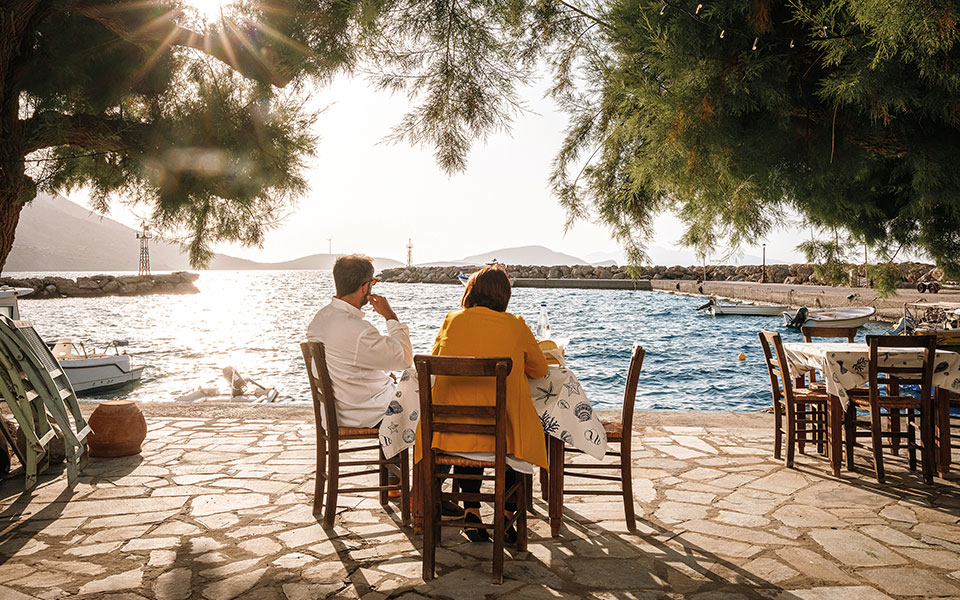
The picturesque fishing village of Aghios Antonios.
© Michael Pappas
Tilos is a small island between Kos and Rhodes in the Dodecanese, with a population of about 500 permanent residents. According to mythology, it got its name from Tilos, the son of Alia, sister of Helios. The myth says that when Alia fell ill, Tilos came to this island to gather herbs to cure her. Once she recovered, he built a temple here in honor of the god Apollo.
The capital of Tilos is Megalo Horio, the port is called Livadia, and there are two other settlements: Eristos and Aghios Antonios. There are many spots of archaeological and religious interest, including the chapel of Panagia Politissa, dating from 1879 and just 2.5 kilometers from the port, as well as the abandoned settlement of Gera where, up until WWII, the residents of Mikro Horio maintained seasonal shelters they lived in while farming in the summer fields.
Over the past decade, Tilos has been trying to establish itself as a model for sustainable tourism. It came to be known as the first “green” island in the Mediterranean by providing its residents with energy sourced exclusively from renewable resources. The island is home to a single wind turbine, located in a remote site on Akri Punta Cape, and a small photovoltaic park. Tilos also became the first island in the world to abolish landfills; instead, it has implemented a comprehensive waste management program, Just Go Zero Tilos. This more environmentally friendly approach, in combination with the variety of activities on offer, such as hiking and birdwatching, as well as its beautiful beaches, makes Tilos a compelling summer destination and a role model for sustainable tourism.
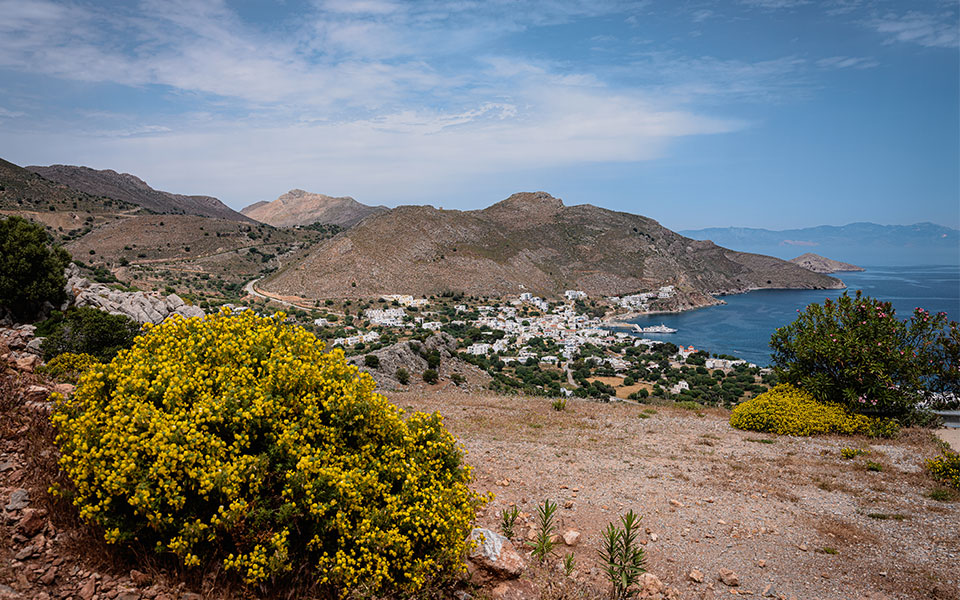
© Michael Pappas
With Byzantine chapels, abandoned settlements and a crisscrossing network of old stone walls, Tilos is filled with surprises; perhaps none are more charming than its main village. Birds chirp in the branches of fig and aromatic lemon trees that cast shade over quaint courtyards. The village’s labyrinthine alleyways are often just wide enough for two persons to pass. Throughout the streets, there are whitewashed walls and colored doors and sets of steps framed by bougainvilleas, and sometimes you come across a wild goat right here in the village. A section of the settlement’s ancient wall, which dates from the first half of the 4th century BC, is still visible; on Tilos, the past lives in the present.
Megalo Horio is built amphitheatrically on the western slope of Aghios Stefanos mountain, under the medieval castle of Messaria, one of the seven castles on the island. Inside the castle walls once stood the ancient temple of Zeus Polieus and Athena Polias, while today the Church of the Taxiarchis can be found here. Reaching the castle via the footpath should take about half an hour; the path traverses the ancient settlement dating from the Classical and Hellenistic periods. “The houses of the 4th-century BC Doric town were built higher up on the slopes than the houses we see today. They were mostly rectangular in shape and were built over large tanks that collected rainwater,” explains architect Seva Vasilara, who has restored over 25 traditional residences in Tilos.
The gorgeous cobblestone square, adjacent to the Church of the Archangel Michael and the Old Town Hall, lies at the heart of the village, but as sunset begins, it’s perhaps best to head for the Church of the Panagia to admire the views down to Eristos Beach.
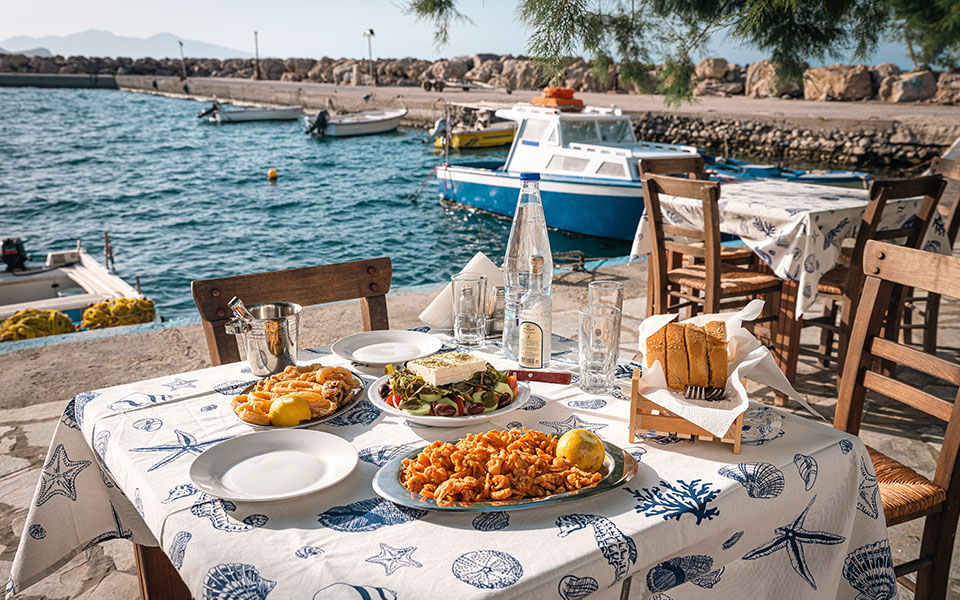
“To Delfini” taverna
© Michael Pappas
In the fishing village of Aghios Antonios, in the northern part of the island, you’ll come across a fully-equiped dairy that’s housed in a shipping container! The Irinna dairy uses goat’s milk to produce cheeses such as thalassotyri, a fresh cheese immersed in saltwater for 24 hours, and other products. At the shore, you’ll find an ancient cemetery that dates to 655-657 B.C., with fossilized skeletons still visible under the water. At the edge of the settlement, Eleni Kamma has been serving seafood delicacies and home-cooked dishes for the last 35 years at “To Delfini” taverna.
She pickles capers, prepares her own fava, fries fish caught the same day, and makes the famed Tilos kid goat cooked in parchment paper. For something sweet after dinner, head to the neighboring cafe, “O Gialos,” to indulge in exceptional Greek coffee and handmade sweets such as galaktoboureko, a treat rich in custard. This is a very relaxing spot, and the trees offer plenty of shade, so you can come here during the day as well.
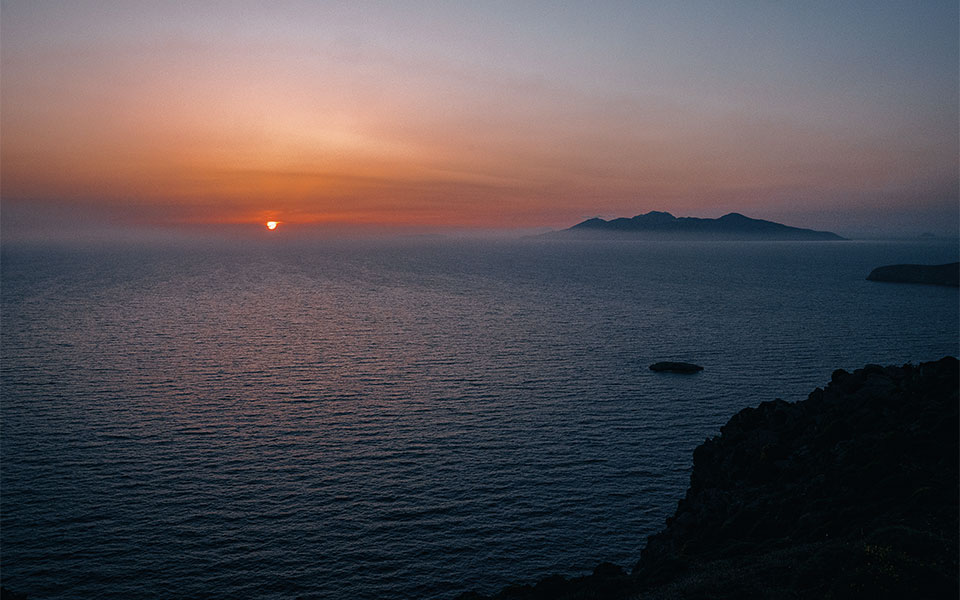
Sunset at Aghios Panteleimonas
© Michael Pappas
Built on a desolate slope of Kriallos Hill in the northwestern part of Tilos, the Monastery of Aghios Panteleimonas was founded in 1470 by the monk Jonas and renovated in 1703. Its courtyard, surrounded by very tall cypress trees and old plane trees, is paved with a wonderful black and white pebble mosaic. The building complex, with its stone tower, low doors and narrow streets, is reminiscent of a small citadel. As the bullet marks on the outer metal-plated door attest, the monastery was often attacked by pirates; financially independent and boasting a water mill, olive mills and a sheep pen, it was a tempting target.
Its wooden iconostasis was created in 1714, while the Christ Pantocrator fresco in the dome and the Holy Trinity fresco on the interior arch date from 1776. Standing at an elevation of 270m, it offers views to Nisyros and Kos. As the sun sets, the mist that forms around Nisyros in the distance makes it seem as if that island is floating on air. Be careful while driving in the neighborhood of the monastery; the road twists and turns, and landslides are known to occur.
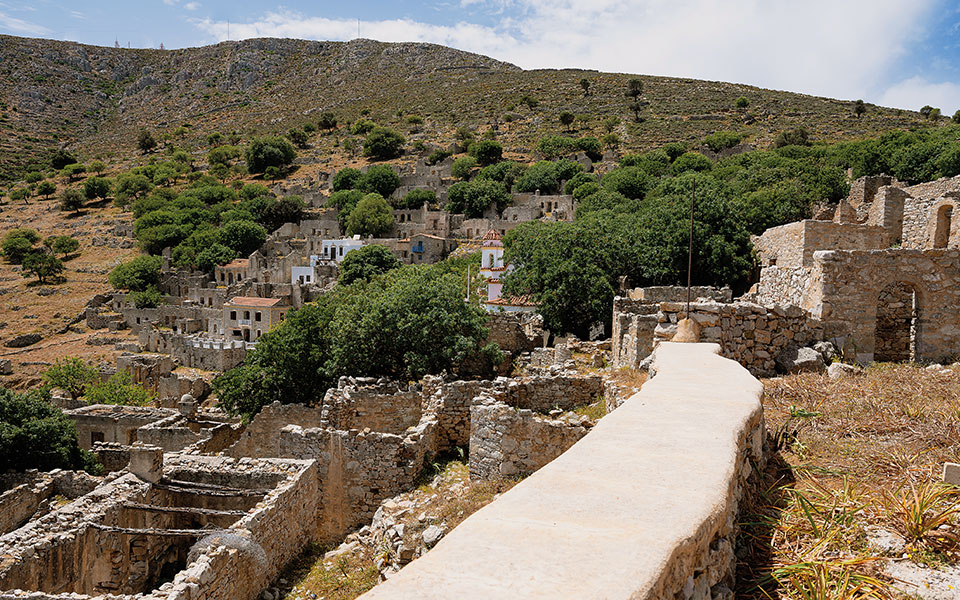
© Michael Pappas
Time stopped forever in Mikro Horio in 1957. That was when the last resident of the medieval settlement moved away, and it remains completely abandoned to this day. After WWII, poverty and drought pushed its population, once 700 strong, towards Livadia. As they left, they took with them sections of the roofs and window frames, because timber was scarce. They were all either farmers or animal breeders or both, and many of them worked in fertile fields that were owned by residents of Megalo Horio. Their houses in Mikro Horio were, for the most part, one-roomed, as they would only go home to sleep. The empty village is the site of one of the more notable chapels of the 125 such buildings scattered across the island; the restored Timia Zoni chapel, with its rare fresco of Saint Christopher the Cynocephalus (“Dog-headed”). When night falls, life comes back to the settlement, even if just for the evening, as patrons of the Mikro Horio Bar gather to have a quiet drink. With the low lighting and the tranquil setting, it seems as if you’re on a movie set.
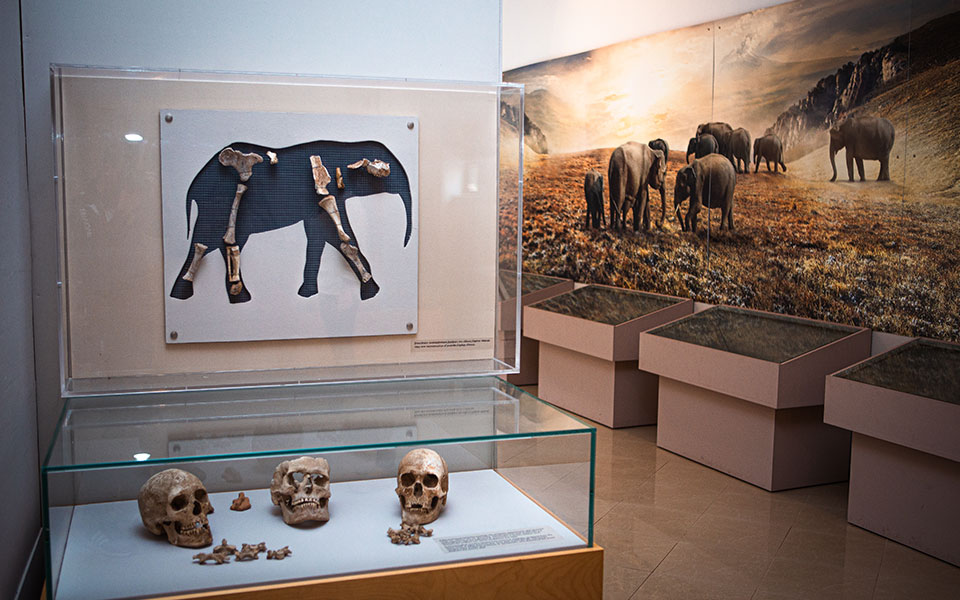
© Michael Pappas
Two million years ago, the area that’s now strewn with the islands of the Aegean was a single landmass scholars call Aegeida. Before rising sea levels created the island archipelago we know today, herds of animals could move across the land-bridge between Europe to Asia. In the Cave of Harkadio on Tilos, 15,000 bones from 100 dwarf elephants were discovered in 1971, the last of their kind in Europe. These mammals, which reached a height of 170 centimeters, arrived some 45,000 years ago; they became extinct around 2000 BC. Experts believe they took advantage of a much shallower sea to swim to the island.
From the bones of deer, elephants and turtles found in the cave, research shows that the elephants coexisted with humans but that the deer had disappeared before the elephants arrived. In the Paleontological Museum near Megalo Horio, you can admire the fossilized bones of these dwarf elephants. The island’s Archaeological Museum, which will house objects, including golden jewelry, and examples of ancient inscriptions from the Classical and the Hellenistic periods, is expected to open in the summer of 2023.
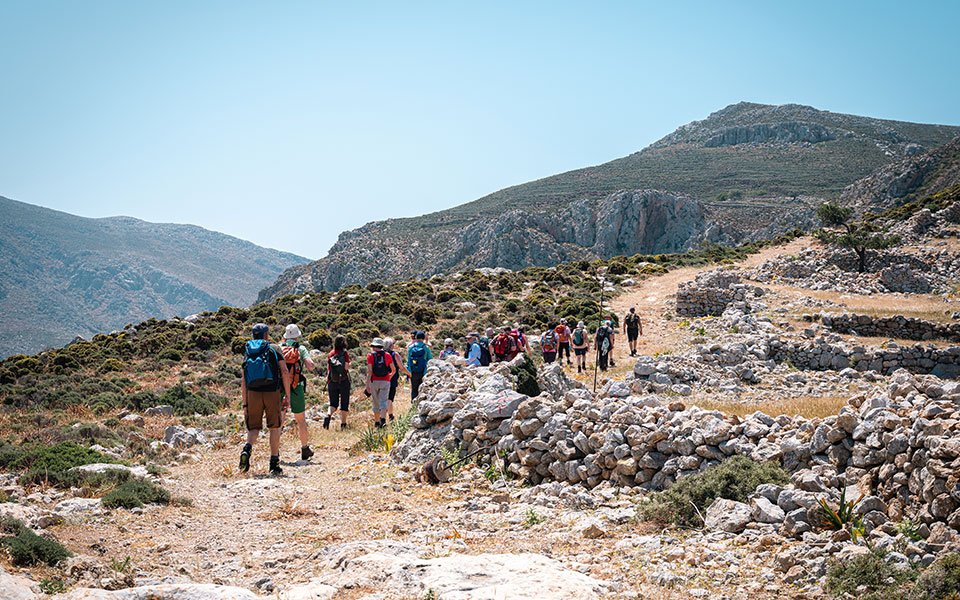
Tilos has a network of walking paths.
© Michael Pappas
Tilos has a large network of footpaths, some signposted, that extends across the entire island. The island’s twelve hills are teeming with wild orchids, brushwood and all types of herbs, the perfect breeding ground for more than 100 bird species, 46 of which are endangered. Thankfully, hunting has been banned since 1993. At the “Ligo apo ola” store on the main square in the village of Livadia, you’ll find a map showing all the hiking routes on the island. It costs €5 and includes information on the difficulty levels of each hike and useful notes on the various natural features and historic and cultural monuments you’ll encounter en route. Tilos doesn’t have tall vegetation to offer much shade, so you’ll need to head out early in the morning and bring a hat and water.
We walked for about an hour from Livadia to the abandoned agricultural settlement of Geras. At the white Chapel of Aghios Ioannis on the way, we encountered 20 German hikers ready to head off to Despotis Nero Beach. A bit further up, personal trainer Zafiris Economou, born and bred in Tilos, was running down the mountain. “I love running on the edge of the slope with views of the sea and the coastline,” he says. The open-air gym “Street Workout” he set up on Livadia Beach welcomes locals and visitors and also operates as a training ground for groups of professional athletes from abroad.
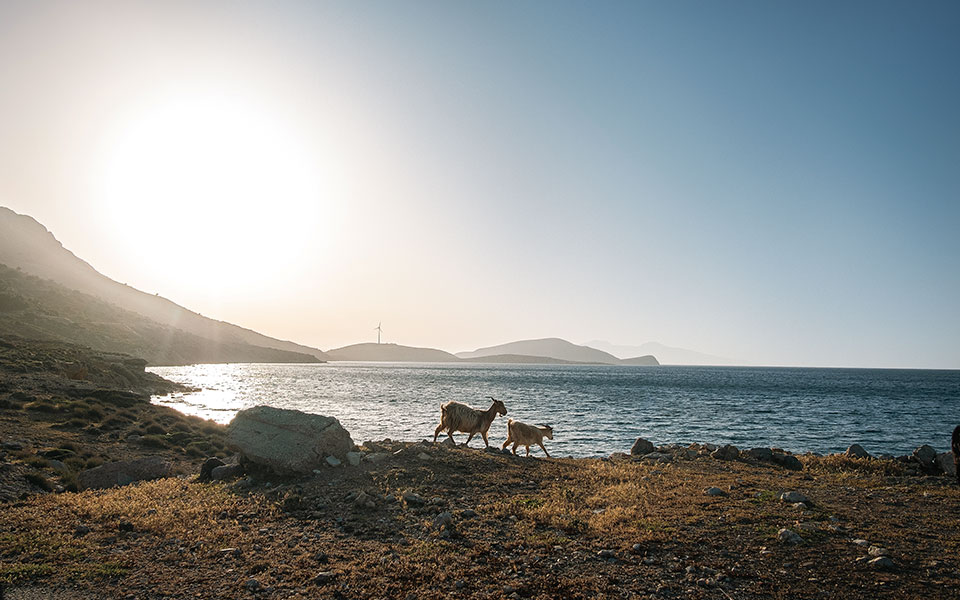
© Michael Pappas
On the northwestern edge of the island, four kilometers from the fishing village of Aghios Antonios and beyond the Chapel of Kamariani, you’ll find Plaka, a small beach with crystalline waters and fine pebbles mixed with sand, and a tall tamarisk tree for shade. Turkey is visible across the water, and there’s dense vegetation here, including eucalyptus, cedar and pine trees. This unexpected mini forest, where wild peacocks roam, is ideal for summer picnics and reading in the shade of the trees. The peacocks may, once they’ve become accustomed to you, even follow you to the water’s edge. It’s also an ideal spot to enjoy the sunset, and it’s quiet; even in August, Plaka doesn’t attract crowds.
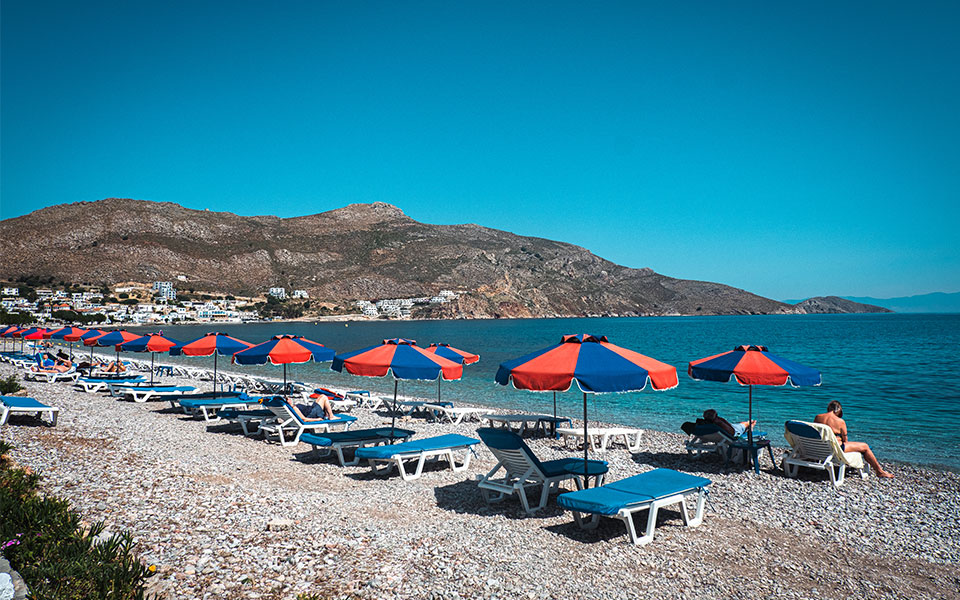
Livadia beach
© Michael Pappas
Tilos has 19 beaches, most accessible via footpaths or from the sea. Few are serviced; some stretches with sun loungers can be found near Livadia. Impressive Eristos is an sandy beach with some pebbles at end of the fertile valley of Megalo Horio. The municipal electric bus from Livadia stops here (€3 per ride). Cedar and tamarisk trees offer shade to the campers that gather each summer. To avoid the crowds, take the small footpath on the eastern side that leads to a small bay. You need to be careful in the water because the shallows have slippery algae-covered sandstone slabs. You’ll find more blue waters on the other side of the island, at Lethra.
We followed the cobbled footpath from Mikro Horio and passed wild pear, almond and terebinth trees (the last used in antiquity for perfumes and medicines) before reaching the long pebble beach about 30 minutes later. Just before Lethra, we passed Kokkini Beach, hidden in a small south-facing bay. The iron in the sand gives the beach its characteristic reddish color; “kokkini” is Greek for “red.” Perhaps the island’s best waters can be found in the sea around the islet of Prasouda, whose sharp rocks provide perches for seagulls.
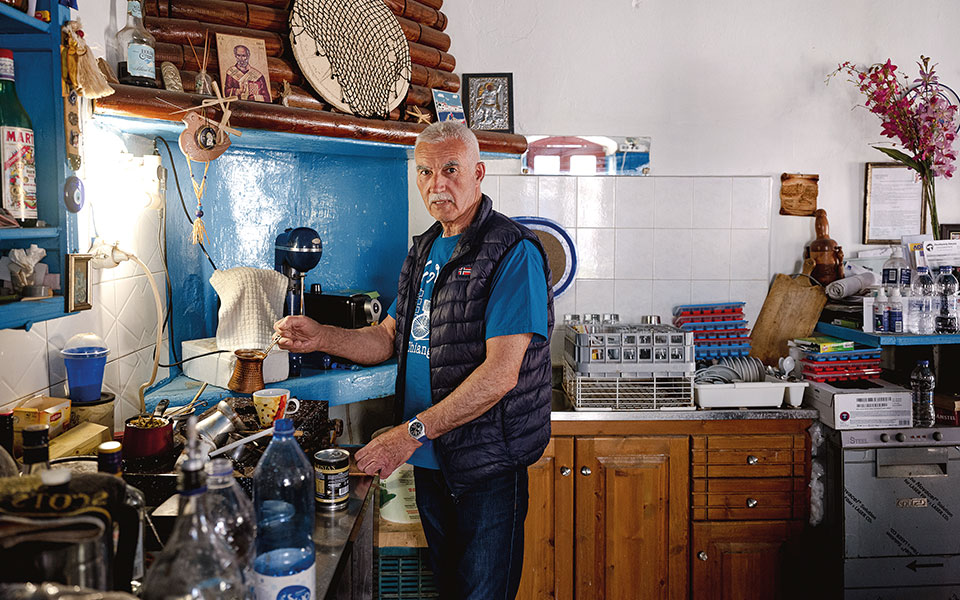
Giorgos Charalambakis, owner of the oldest coffee shop on the island.
© Michael Pappas
In partnership with the Municipality of Tilos, and with permission from the Administrative Region of the Southern Aegean, the company Polygreen is implementing the Just Go Zero Tilos project, a comprehensive cyclical waste management program. Ιts goal is the complete reuse and recycling of all waste. You can learn more at the information center in Livadia Square, and pick up a fabric bag to use for your shopping during your stay here. Make sure to separate your trash and place it in the appropriate bag, as all businesses, private houses and government facilities on the island already do.
Irinna Dairy, Tel. (+30) 694.556.4090
Taverna To Delfini, Tel. (+30) 22460.442.52
Kafenion O Gialos, Tel. (+30) 22460.438.55
Monastery of Aghios Panteleimonas, Tel. (+30) 22420.316.76
Mikro Horio Bar, Tel. (+30) 694.375.4300
Paleontological Museum, open every day, 09:00-20:00
Street Workout by Zafiris, Tel. (+30) 693.753.9151
Patmos Aktis, Resort & Spa combines...
Charming architecture, unique beaches, rich history,...